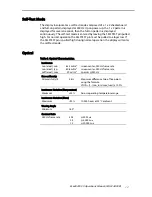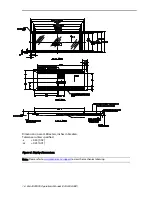
EL640.200-SK Operations Manual (020-0348-00B)
9
Interface Information
This Planar EL display has two types of video interfaces for buffered and non-
buffered modes. Changing from buffered to non-buffered mode or vice versa
can be done during operation of the display. Pull VIDMODE, pin 18, low for
non-buffered mode, and pull it high or leave it disconnected for buffered
mode.
This display includes an internal frame buffer that is active when the display is
in buffered mode. In buffered mode, the display scan rate and the display
brightness are independent of user-supplied input data timing. The display
frequency is controlled through the digital dimming feature as described
below.
Buffered Video Mode
The input timing in the buffered mode is compatible with standard 4-line LCD
single-scan controllers made by a variety of manufacturers. Designers should
select the chip set that best suits their particular architecture and price point.
The display scan rate, set by LUM0 and LUM1, is independent of the input
video frame rate. This allows the user to achieve maximum brightness even at
low input video frame rates for minimizing power consumption and EMI.
In buffered mode, four preset display scan rates can be selected. In addition to
these four luminance steps, an analog luminance-control function is available
(see Dimming on page 11). Due to the timing independence of the input data
and the display scan, an image will be shown on the display even without any
video input data. When using averaging grayscale algorithms, visual artifacts
may be more easily perceived in buffered mode than in non-buffered mode.
Note:
The display includes an internal frame buffer. In buffered mode the display scan is
independent of the input video. In order to blank the display image in the event of system
malfunction, pull VIDMODE low to exit the buffered mode.
Non-buffered Video Mode
The input timing in non-buffered mode is an eight-line dual-screen interface.
The display panel is divided into an upper screen (rows 1 through 100) and a
lower screen (rows 101 through 200). Four pixels for each screen—eight pixels
total—are input on every video clock cycle. The video interface in non-
buffered mode is similar to what is used to drive monochrome dual-panel LCD
displays. The non-buffered mode provides the user with full control of the
display scan rate. It also enables the use of gradual dimming with frame rate
and the use of averaging grayscale algorithms. For additional dimming
independent of frame-rate, an analog luminance-control function is available
(see Dimming on page 11).
In non-buffered mode, video data must be supplied continuously. If the
supported frame rate range of the available display controller limits the
achievable brightness, the buffered mode can be used for high-brightness
operation.






































